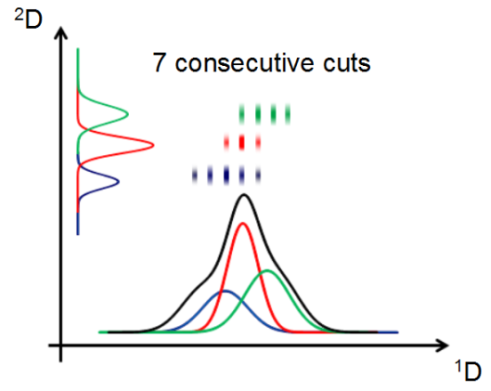High Resolution Sampling
High-Resolution sampling combines the advantages of the Comprehensive 2D-LC and Multiple Heart-cutting modes, allowing the analysis of potentially unresolved peaks in the first dimension that are too broad for parking to a single sample loop. Up to 10 consecutive cuts can be created with widths down to about 2 µl, which corresponds to less than a second of 1D retention time.

In contrast to heart-cutting mode, the entire 1D peak can be transferred to the second dimension. This ensures that no compounds are missed, and allows precise quantitation. Peak parking is more precise than for heart-cutting, as both start and end of a cut are clearly defined; heart cutting, on the other hand, determines cuts by switching the valve only at the end of a cut. As in multiple heart-cutting, the second dimension is decoupled from the first dimension using parking decks with sample loops; this allows long gradients and a high resolution in the second dimension.
In contrast to full comprehensive mode, where consecutive cuts can take, for example, 30 seconds, the 1D resolution is retained with high-resolution sampling.
Multi-Inject
If High-Resolution data is acquired in multi-inject mode, then the respective series of cuts of all applicable sample loops per deck valve is injected subsequently and then analyzed in one second dimension separation. So, instead of a single 2D chromatogram per cut, there is just one 2D chromatogram for all cuts that are analyzed together in each multi-inject series. That is, if a high-resolution series uses two deck valves, this will result in two 2D chromatograms.
The separate cuts of a multi-inject series are displayed in the Sampling Table and annotated in the 1D chromatogram. But, in the Contour Plot and Diagnostic Signals windows of the second dimension, the multi-inject run is displayed as one cut run.